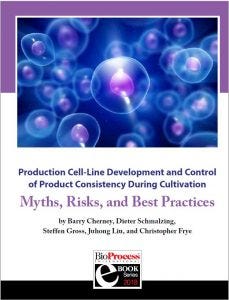eBook: Production Cell-Line Development and Control of Product Consistency During Cultivation — Myths, Risks, and Best PracticeseBook: Production Cell-Line Development and Control of Product Consistency During Cultivation — Myths, Risks, and Best Practices
 Health authorities are requesting substantial details from sponsors regarding practices used to generate production cell lines for recombinant DNA–(rDNA) derived biopharmaceuticals.
Health authorities are requesting substantial details from sponsors regarding practices used to generate production cell lines for recombinant DNA–(rDNA) derived biopharmaceuticals.
Authorities also are asking for information about the clonality of master cell banks (MCBs) and control strategies to minimize genetic heterogeneity. Such requests are prompted by recent reports indicating “nonclonality” for certain production cell lines. To address these and related issues, the CASSS CMC Strategy Forum on “Production Cell Line Development and Control of Product Consistency During Cell Cultivation: Myths, Risks and Best Practices,” was held 23 January 2017 in Washington, DC. The overarching objective of this forum was to define myths about and risks to cell line development and product quality associated with cell cultivation. Forum participants identified current best practices to ensure that sponsors meet regulatory expectations when assessing and assuring the appropriateness of cell lines for biopharmaceutical production during development and commercialization.
This report summarizes considerations for development of production cell lines including
The choice of expression system
Strategies to minimize genetic heterogeneity of production cells
The characterization of cell population genetic heterogeneity and potential approaches to improve cell line performance through hostengineering
Assurance of consistent production of desired product
Approaches to ensuring appropriate control of product quality throughout a cell culture process, including advancements in analyticalcontrol strategies
Strategies for accelerating early product development though the use of pool clones
Lifecycle management of production cells.
The forum offered introductory presentations by representatives of regulatory agencies including the FDA and the EMA and by industry representatives. Their presentations were followed by panel discussions of selected topics of interest.
Just fill out the form to view and download the complete eBook.
You May Also Like






